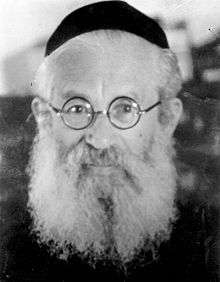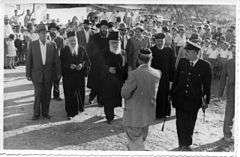Yitzhak HaLevi Herzog
Yitzhak HaLevi Herzog (Hebrew: יצחק אייזיק הלוי הרצוג; 3 December 1888 – 25 July 1959), also known as Isaac Herzog or Hertzog,[2] was the first Chief Rabbi of Ireland, his term lasting from 1921 to 1936.[3] From 1936 until his death in 1959, he was Ashkenazi Chief Rabbi of the British Mandate of Palestine and of Israel after its independence in 1948.
Rabbi Yitzhak HaLevi Herzog | |
|---|---|
 | |
| Title | Ashkenazi Chief Rabbi of Israel |
| Personal | |
| Born | 3 December 1888 |
| Died | 25 July 1959 (aged 70) |
| Religion | Judaism |
| Nationality | Irish, Israeli |
| Jewish leader | |
| Successor | Isser Yehuda Unterman |
| Began | 1948 |
| Ended | 1959 |
| Other | Chief Rabbi of Ireland (1919–1936) Ashkenazi Chief Rabbi of the British Mandate of Palestine (1936–1948) |
| Buried | Sanhedria Cemetery, Jerusalem, Israel[1] |

Biography
Isaac Halevi Herzog was born in Łomża, Poland, the son of Liba Miriam (Cyrowicz) and Joel Leib Herzog. He moved to the United Kingdom with his family in 1898, where they settled in Leeds. His initial schooling was largely at the instruction of his father who was a rabbi in Leeds and then later in Paris.[4]
After mastering Talmudic studies at a young age, Yitzhak went on to attend the Sorbonne and then later the University of London, where he received his doctorate. His thesis, which made him famous in the Jewish world, concerned his claim of re-discovering Tekhelet, the type of blue dye once used for the making of Tzitzit.[5]
Rabbi Herzog's descendants have continued to be active in Israel's political life. His son Chaim Herzog was a general in the Israel Defense Forces and later became ambassador of Israel to the UN and President of Israel. His son Yaakov Herzog served as Israel's ambassador to Canada and later as Director General of the Prime Minister's Office. He also accepted an offer to become Chief Rabbi of the British Commonwealth but due to ill health never took up that role. His grandson Isaac Herzog was a member of the Knesset, Israel's parliament, and head of the opposition. He previously served as housing and tourism minister and minister of welfare.
Rabbinic career
Rabbi Herzog served as rabbi of Belfast from 1916 to 1919 and was appointed rabbi of Dublin in 1919. A fluent speaker of the Irish language, he supported the First Dáil and the Irish republican cause during the Irish War of Independence, and became known as "the Sinn Féin Rabbi".[6] He went on to serve as Chief Rabbi of Ireland between 1922 and 1936, when he immigrated to Palestine to succeed Rabbi Abraham Isaac Kook as Ashkenazi Chief Rabbi upon his death. He became a supporter of both the Irish Republican Army and the Irgun.[7]
In May 1939, shortly before the Second World War, the British put out the White Paper of 1939 restricting Jewish immigration to Palestine. After leading a procession through the streets of Jerusalem, with an unusually united Jewish following from all sects, on the steps of the Hurva Synagogue he turned and said: "We cannot agree to the White Paper. Just as the prophets did before me, I hereby rip it in two." Some 40 years later, on 10 November 1975 Ambassador Herzog repeated his father's gesture with the UN resolution that Zionism is equal to racism.[8]
During the Second World War, Rabbi Herzog travelled with great risk to the US, and back, not before he was able to secure a meeting with Roosevelt. Roosevelt smiled and did not reply to the Rabbi's pleadings for a promise to help the Jews of Europe. His biographer records that several people noticed that his hair turned white when he left the meeting, which he perceived as a failure. Following this, he immediately returned home, missing the ride on a ship that was sunk by a U-boat, and taking what was said to be the last civilian ship to cross the Atlantic during the war.
After the war, Rabbi Herzog dedicated himself to saving Jewish children especially babies and bringing them back from their places of hiding throughout all of Europe, to their families or to Jewish orphanages. Many of these were hidden in Christian monasteries or by Christian families, and refused to return them. In his biography, he tells of the difficulties he had of meeting the Pope who avoided him, but did receive in the end assistance from the Vatican. In later years it was found that Karol Wojtyła, future Pope John Paul II, was the contact who helped the rabbi out.[9] However, defenders of Pope Pius XII have asserted that Herzog had maintained friendly relations with the pontiff during and after the World War II. In 1945, he stated: “The people of Israel will never forget what His Holiness and his illustrious delegates are doing for our unfortunate brothers and sisters in the most tragic hour of our history, which is living proof of Divine Providence in this world.” [10]
Published works
Rabbi Herzog was recognised as a great rabbinical authority, and he wrote many books and articles dealing with halachic problems surrounding the Torah and the State of Israel. Indeed, his writings helped shaped the attitude of the Religious Zionist Movement toward the State of Israel. Rabbi Herzog authored:
- Main Institutions of Jewish Law
- Heichal Yitzchak
- Techukah leYisrael al pi haTorah
- Pesachim uKetavim
- The Royal Purple and the Biblical Blue
Awards and recognition
- In 1958, Rabbi Herzog was awarded the Israel Prize, in Rabbinical literature.[11]
See also
- History of the Jews in Ireland
- History of the Jews in Northern Ireland
- Herzog (disambiguation)
- Shmuel Wosner
- List of Israel Prize recipients
References
- "All Israel Mourns Death of Chief Rabbi Herzog, Buried in Sanhedria" (PDF). Daily News Bulletin. Jewish Telegraphic Agency. 27 July 1959. p. 1. Retrieved 1 April 2017.
- The spelling 'Hertzog' appears on his official letter of recommendation for Rev. Joseph Unterman, November 1938, both in the signature and also in the seal
- "Herzog, Chaim (1918–1997)". Israel and Zionism. The Department for Jewish Zionist Education. Archived from the original on 26 September 2007. Retrieved 5 November 2007.
- Herzog, Chaim (1996). Living History – A Memoir. New York: Pantheon Books. p. 6. ISBN 978-0-679-43478-8.
- Herzog, Chaim (1996). Living History – A Memoir. New York: Pantheon Books. p. 7. ISBN 978-0-679-43478-8.
- Benson, Asher (2007). Jewish Dublin. Dublin: A&A Farmer Ltd. p. 22. ISBN 978-1-906353-00-1.
- Calder Walton, 'British Intelligence and Threats to British National Security After the Second World War,' in Matthew Grant (ed) The British Way in Cold Warfare: Intelligence, Diplomacy and the Bomb 1945-1975, A&C Black, 2011 pp.141-158 p.151.
- Lammfromm, Arnon (2009). Chaim Herzog, HaNasi HaShishi (Chaim Herzog, the Sixth President) (in Hebrew). Jerusalem: Israel State Archives. p. 296. ISBN 978-965-279-037-8.
- On Popes and Jews, Akiba Zimmerman, Hazofe newspaper archive (Hebrew). It is said as an urban legend, that one tactic he had for proving which children were Jewish, although still in denial or mostly afraid of the monastery staff, would be to call out the Shema Yisroel and Jewish children would instinctively cover their eyes along with him.
- "Pope Pius XII Vicar of Christ Servant of God Deserving of Sainthood". Archived from the original on 16 March 2010.
In February 1945 Chief Rabbi Isaac Herzog of Palestine stated: “The people of Israel will never forget what His Holiness and his illustrious delegates, inspired by the eternal principles of religion, which form the very foundations of true civilization, are doing for our unfortunate brothers and sisters in the most tragic hour of our history, which is living proof of Divine Providence in this world.”
- "Israel Prize recipients in 1958 (in Hebrew)". Israel Prize Official Site. Archived from the original on 8 February 2012.
External links


| Jewish titles | ||
|---|---|---|
| New title | Chief Rabbi of Ireland 1919–1936 |
Succeeded by Immanuel Jakobovits |
| Preceded by Abraham Isaac Kook |
Ashkenazi Chief Rabbi of Mandatory Palestine 1936–1948 |
Position abolished |
| New title | Ashkenazi Chief Rabbi of Israel 1948–1959 |
Succeeded by Isser Yehuda Unterman |